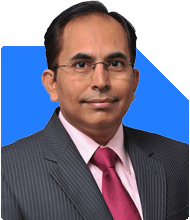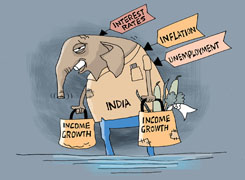Ramalingam Kalirajan |10887 Answers |Ask -Follow
Mutual Funds, Financial Planning Expert - Answered on Jul 01, 2024
He has an MBA in finance from the University of Madras and is a certified financial planner.
He is the director and chief financial planner at Holistic Investment, a Chennai-based firm that offers financial planning and wealth management advice.... more

Income - 30k Monthly rent -14k Emi is 32k with help of my family I am paying. I want to close all emi and pay small amount. Will it be a good option if I take a 1lakh loan for 35% and reduce the monthly emi burden I have gold loan 1.9l Outside loan 65k O/s rent 28000 App loans total o/s 60k I failed to repay few app loans for the past months, cibil got affected and too many loans. No bank is ready to offer any loan. One offer I have is 1l in Bajaj at 35% interest. What should I do and which way works best? Please help me
Assess Your Financial Situation
Income and Expenses:
Monthly Income: Rs. 30,000
Rent: Rs. 14,000
EMI: Rs. 32,000 (with family support)
Gold Loan: Rs. 1.9 lakh
Other Loans: Rs. 65,000
Outstanding Rent: Rs. 28,000
App Loans: Rs. 60,000
Immediate Steps to Take
Avoid High-Interest Loans:
Taking a Rs. 1 lakh loan at 35% interest from Bajaj is very costly and will worsen your financial burden.
Negotiate with Lenders:
Reach out to your existing lenders, explain your situation, and request a restructuring of your loans. They may offer lower EMIs, extended tenure, or a temporary moratorium.
Family Support:
Continue to seek help from family if possible. Consider discussing a temporary increase in their support to ease your immediate burden.
Sell Assets:
If you have any assets that can be sold without significant loss, consider doing so to repay high-interest loans first.
Medium-Term Strategies
Debt Consolidation:
Look for a debt consolidation plan with a lower interest rate. This might be hard given your current credit score, but some non-bank financial companies (NBFCs) offer such services.
Increase Income:
Look for additional income sources, such as part-time work, freelance jobs, or selling unused items.
Financial Counseling:
Consult a Certified Financial Planner (CFP) or a credit counseling agency. They can provide personalized advice and may help negotiate with creditors.
Long-Term Planning
Credit Score Repair:
Once your immediate financial crisis is managed, work on improving your credit score by paying all your dues on time and reducing outstanding debts.
Budgeting:
Create a strict budget to control expenses and prioritize debt repayment.
Final Insights
Taking a high-interest loan to manage current debt can lead to a debt trap. Focus on negotiating with current lenders, seeking family support, and avoiding any additional high-cost loans. Consider selling assets if possible and look for ways to increase your income. Consult a financial counselor for personalized assistance.
Best Regards,
K. Ramalingam, MBA, CFP
Chief Financial Planner,
www.holisticinvestment.in
Prioritize Payments:
Focus on clearing high-interest app loans and local lenders first. This will reduce your overall interest burden.
Family Support:
Request additional temporary financial help from your family. Explain the urgency and your plan to repay once you stabilize.
Sell Unnecessary Assets:
Sell any non-essential items or assets you own. Use the proceeds to clear high-interest debts first.
Local Community Assistance:
Look for local community groups or non-profits that provide financial assistance or short-term loans at lower interest rates.
Temporary Sacrifices:
Consider making temporary lifestyle changes to cut down expenses. Redirect saved money towards paying off loans.
Employer Advance:
Ask your employer for a salary advance or short-term loan. Some companies offer this to employees in financial distress.
Detailed Action Plan
Family Support:
Explain your situation to your family again and request specific amounts to clear app loans and local lenders.
Sell Unnecessary Assets:
Create a list of items you can sell quickly. This could include electronics, furniture, or any other valuables.
Community Assistance:
Research local organizations that might offer financial help. Visit them and explain your situation.
Temporary Lifestyle Changes:
Cut down on non-essential expenses like dining out, subscriptions, or other discretionary spending. Use this money to pay off debts.
Employer Advance:
Discuss your situation with HR or your manager and request a salary advance or loan. Many employers are willing to help employees in distress.
Immediate Income Sources:
Look for quick gigs or part-time work that can provide immediate cash flow. This could be anything from freelancing to temporary jobs.
By following these steps, you can focus on reducing your immediate debt burden without taking on a high-interest loan.
Best Regards,
K. Ramalingam, MBA, CFP
Chief Financial Planner,
www.holisticinvestment.in
You may like to see similar questions and answers below
Ramalingam Kalirajan |10887 Answers |Ask -Follow
Mutual Funds, Financial Planning Expert - Answered on Jun 25, 2024
Milind Vadjikar | Answer |Ask -Follow
Insurance, Stocks, MF, PF Expert - Answered on Dec 23, 2024
Janak Patel |71 Answers |Ask -Follow
MF, PF Expert - Answered on May 20, 2025
Ramalingam Kalirajan |10887 Answers |Ask -Follow
Mutual Funds, Financial Planning Expert - Answered on Jun 04, 2025
Ramalingam Kalirajan |10887 Answers |Ask -Follow
Mutual Funds, Financial Planning Expert - Answered on Jun 21, 2025
Radheshyam Zanwar |6745 Answers |Ask -Follow
MHT-CET, IIT-JEE, NEET-UG Expert - Answered on Dec 15, 2025
Ramalingam Kalirajan |10887 Answers |Ask -Follow
Mutual Funds, Financial Planning Expert - Answered on Dec 15, 2025
Ramalingam Kalirajan |10887 Answers |Ask -Follow
Mutual Funds, Financial Planning Expert - Answered on Dec 15, 2025
Ramalingam Kalirajan |10887 Answers |Ask -Follow
Mutual Funds, Financial Planning Expert - Answered on Dec 15, 2025
Ramalingam Kalirajan |10887 Answers |Ask -Follow
Mutual Funds, Financial Planning Expert - Answered on Dec 15, 2025
Ramalingam Kalirajan |10887 Answers |Ask -Follow
Mutual Funds, Financial Planning Expert - Answered on Dec 15, 2025
Ramalingam Kalirajan |10887 Answers |Ask -Follow
Mutual Funds, Financial Planning Expert - Answered on Dec 15, 2025
Dr Dipankar Dutta |1841 Answers |Ask -Follow
Tech Careers and Skill Development Expert - Answered on Dec 14, 2025
Nayagam P P |10854 Answers |Ask -Follow
Career Counsellor - Answered on Dec 14, 2025
Radheshyam Zanwar |6745 Answers |Ask -Follow
MHT-CET, IIT-JEE, NEET-UG Expert - Answered on Dec 14, 2025
















.jpg)









